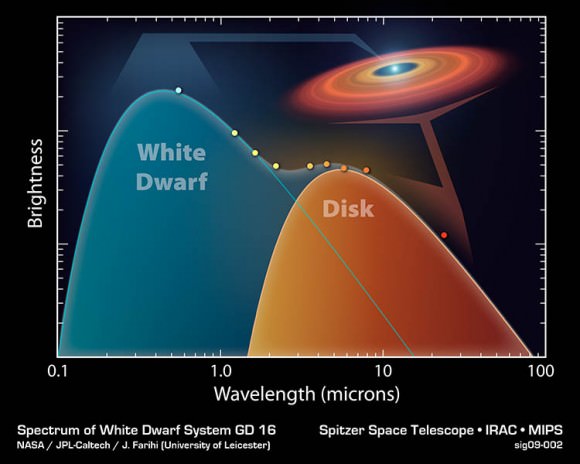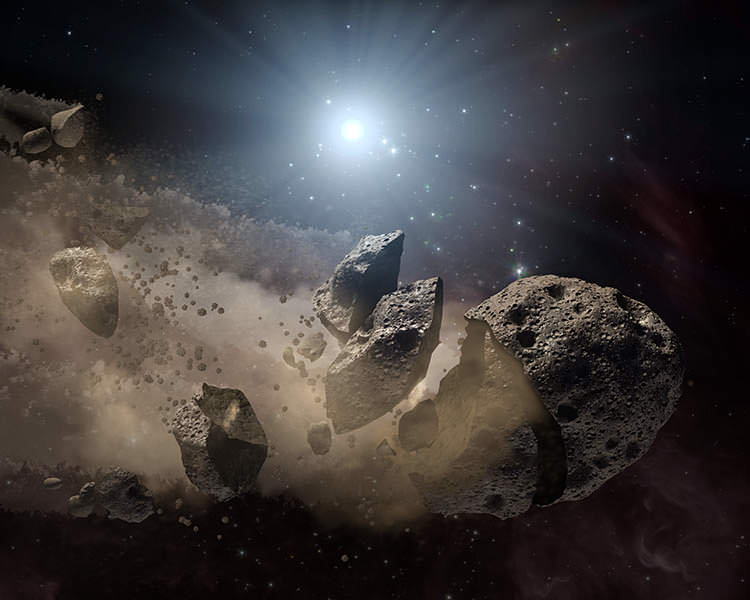[/caption]
Were there once habitable planets long ago around stars that are now dead? A team of astronomers have found evidence that between 1-3 percent of white dwarf stars are orbited by rocky planets and asteroids, suggesting these objects once hosted solar systems similar to our own. White dwarf stars are the compact, hot remnants left behind when stars like our Sun reach the end of their lives. Using data from the Spitzer Space Telescope, an international team of astronomers have determined that asteroids are found in orbit around a large number of white dwarfs, perhaps as many as 5 million in our own Milky Way Galaxy.
The atmospheres of these white dwarf stars should consist entirely of hydrogen and helium but are sometimes found to be contaminated with heavier elements like calcium and magnesium. The new observations suggest that these Earth-sized stars are often polluted by a gradual rain of closely orbiting dust that emits infrared radiation picked up by Spitzer.
Presenting his team’s findings at the European Week of Astronomy and Space Science conference at the University of Hertfordshire, Dr. Jay Farihi of the University of Leicester said that the data from Spitzer suggest that at least 1 in 100 of white dwarf stars are contaminated in this way and that the dust originates from rocky bodies like asteroids (also known as minor planets). In our Solar System, minor planets are the left over building blocks of the rocky terrestrial planets like the Earth.
“In the quest for Earth-like planets, we have now identified numerous systems which are excellent candidates to harbour them,” said Farihi. “Where they persist at white dwarfs, any terrestrial planets will likely not be habitable, but may have been sites where life developed during a previous epoch. “
The new findings indicate the dust is completely contained within the Roche limit of the star — close enough that any object larger than a few kilometers would be ripped apart by gravitational tides (the same phenomenon which led to the creation of Saturn’s rings). This backs up the team’s hypothesis that the dust disks around white dwarfs are produced by tidally disrupted minor planets. In order to pass this close to the white dwarf, an asteroid must be perturbed from its regular orbit further out – and this can occur during a close encounter with as yet unseen planets.
Because white dwarfs descend from main sequence stars like the Sun, the team’s work implies that at least 1% to 3% of main sequence stars have terrestrial planets around them.

Perhaps the most exciting and important aspect of this research is that the composition of these crushed asteroids can be measured using the heavy elements seen in the white dwarf.
Farihi sees this as a crucial step forward. “With high quality optical and ultraviolet observations (e.g. the Hubble Space Telescope), we should be able to measure up to two dozen different elements in debris-polluted white dwarfs. We can then address the question, “Are the rocky extrasolar planets we find similar to the terrestrial planets of our Solar System?”
Source: RAS


Great another another ‘just so’ story.
I look forward to the hard data not just the ‘just so’ overlay.
Kind Regards,
Paul
It’s the bleeding edge of interpreting minimal data gleaned at the very extreme of our reach Paul… what do you want? fries with that?
some popcorn speculation about habitable planets left after the star declined to a white star woud be great
Can’t please everybody it seems.
I think it’s amazing what can reasonably be inferred by such a paucity of direct data from those stars. Can’t image the dust in detail, but we can figure a lot out from even an blurred point of light.
Well, if we could resolve planets close enough or visit systems like that we might have a better chance of seeing how common intelligent life is by the ruins left behind. An evolving solar system might still yet evolve life, while a dead system would have the record right there.
Of course that’s the same as saying “If we had some ham, we could have ham and eggs – if we had some eggs.”
Popcorn Speculation. 🙂
Well as we are talking about a Dwarf, the assumption is that it forms after they expand to be a Red giant. A fate that is well publicized as being the likely state of our own star as it ages.
So any civilization orbiting the original sun would have had to avoid this expansion rate by moving their planet to avoid being swallowed by very hot plasma.
The then remaining “white dwarf” core, having no fuel to burn is quite cold. (eventually) but at first its incredibly hot.
So you might want to bring your planet in closer once it starts to cool down.
However it is also becomes a candidate for a nice cataclysmic supernova event.:)
So our civilization had want to be en route to another star by this stage. I would.
However If our super advanced civilization has evolved successfully and survived the changes to their sun, then they one day will have the pleasure of witnessing a Black Dwarf.
Which is a concept we have invented to explain what might happen to a a (White Dwarf) once if finally runs of of things that make it glow.
Of course you have to accept at face value that our current ideas about what stars are and how they work as a good work in progress.
As no Black Dwarfs are thought to exist yet.
Damian
@ mrt181’s ..”some popcorn speculation about habitable planets left after the star declined to a white star woud be great”
the article cited
“Where they persist at white dwarfs, any terrestrial planets will likely not be habitable, but may have been sites where life developed during a previous epoch. “
…put down your popcorn mate..then you might engage enuff neurones to read the article properly.. be sure you are sitting down when you do.. a random moment of understanding might disrupt your complacent equilibrium
Hey OilsM….. what about gravity??
This is fascinating work but I don’t follow the conclusion about terrestrial planets: wouldn’t gas giants be equally good, if not better, at diverting asteroids into the tidal disruption zone?
I enjoyed everyone’s posts but Damien’s sticks out for me. What does everyone think about the planets moving outward as the star expands to red giant? Someone had a mathematical model that made this scenario a possibility. With so many unknown variables, it was more or less a ‘for your consideration’ type paper. Does anyone have a link to it?
It isn’t that you cannot please everyone. In this case, it is a case of ignorance having to babble out nonsense.
There is a lot in this article if you actually read it, and grasp what is being said. The fact there is pollution on a white dwarf can lead to some pretty good speculation, and therefore research.
Everything can’t be Lego blocks.
It’d be interesting to know the ages of the white dwarfs with the most contaminants. I betcha there’s more dust associated with younger white dwarfs – indicating leftover material from their days as a “normal star”. I’d also bet that the dusty stars have spectacular rings – much like a “giant Saturn”.
more Popcorn Speculation:
What would a White Dwarf Sun look like in the sky? Like a Frisbee, seen edge-on? I imagine it’d be quite flattened….
And you’d have to be orbiting pretty close – to see it at all, at all!
thanks man!!!!!
more real than most think!!!!!!
PLANET X THE REAL CAUSE OF GLOBAL WARMING.2009
http://www.mininova.org/tor/2503356
@TomMcIntire
I remember speculating (dangerous for me at my age) when reading articles describing the phase of the Red Giant and our fate in a few billion years, that if during the transition into a Red Giant, an enormous amount of its mass/energy would be continually lost to interstellar space and thereby reducing its gravitational tug on the planets. The planets would then gradually move, in proportion to the lost mass and hopefully in some orderly manner, to more distant orbits.
Help! Is there an Orbital Mechanic in the house? lol
I’m with Will on the borderline of ignorance ([i]pace[/i], friend), but 180deg around the track when I speculate the enveloping hot plasma field of the Red Giant phase would cause drag and inward spiralling of planets as orbital velocity is lost. This also handily brings the magnesium and caclium contaminants (possibly) into range of the abovementioned tidal forces.
I was considering the gradual increase of the orbits would stay beyond the envelope. Of course, I’m assuming the swell into the giant is gradual. Otoh, I may be beating a dead horse here.lol
It should have read. the progression of the swelling would be gradual, to make more sense.
The research team should look for spectral evidence of complex synthetic organic compounds or there breakdown products. I’ve often heard that many of the synthetic compounds humans have made since the 1950s will exist until the end of the universe. So that when then Sun goes nova these compounds residing in the crust of the Earth will be vapourized and distributed in the dust around the resulting white dwarf. Looking for these compounds may be the interstellar equivalent of “I was here” graffiti.
The birth of planetary systems is closely tied to the death of precursor stars.
The first planetary system beyond our own was discovered by Alexander Wolszczan and Dale A. Frail [See: “A planetary system around the millisecond pulsar PSR1257+12,” Nature, 255, 145 (1992)]:
Three Earth-like planets orbiting the collapsed core of a supernova – a pulsating neutron star – a pulsar!
With kind regards,
Oliver K. Manuel
http://www.omatumr.com